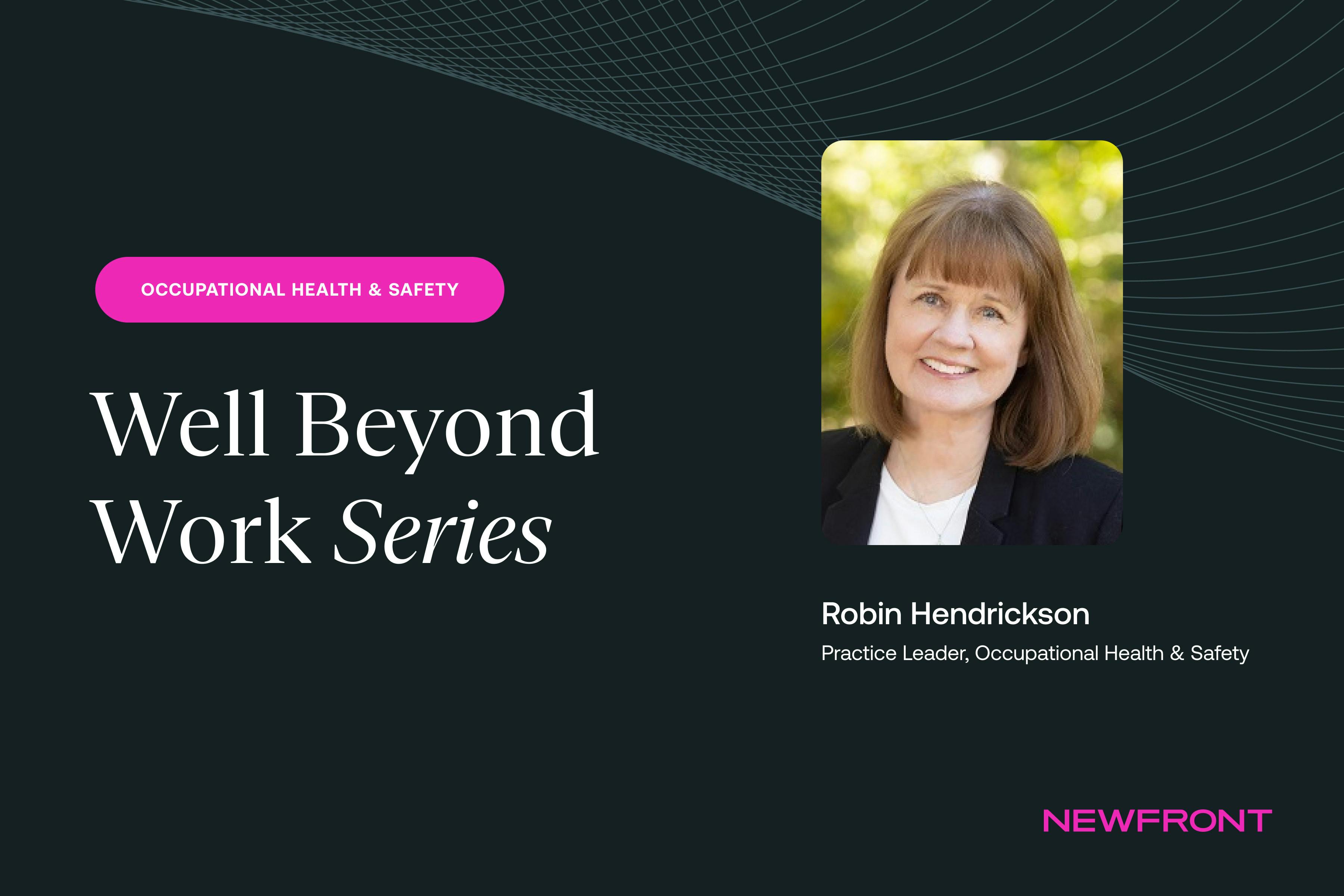Well Beyond Work: Strengthening your Health, Disability, and Workers’ Compensation Benefit Plans
By Robin Hendrickson | Published November 11, 2020

As an Occupational Health & Safety consultant, I have always considered workers’ compensation (WC) to be an integral part of an employer’s health care, disability, and lost wage benefit plans. When an individual is injured or develops an illness or disability, they need medical care whether it occurs on or off the job. Depending upon the severity of the medical condition which prevents the employee from returning to work, they will also need income replacement benefits. Conventionally, primary health care, disability and workers’ compensation insurance have been purchased separately or independently managed under self-insured plans and administered internally by various stakeholders of an organization. This can present a missed opportunity for a multidisciplinary strategy and program design focused on overall employee health, safety, and well-being on and off the job.
During my tenure working in the insurance and risk management field, I have learned how the consequences of poor health, chronic diseases, and unhealthy behaviors can contribute to disability and health claims, in addition to significantly impacting the cost, duration, and recovery of a WC claim. To understand how benefit plans are interconnected with health related similarities, it is noteworthy to look at a few facts on the general health of Americans, healthcare costs, most prevalent types of health issues, and how employee’s health problems can impact all benefit plans and an employer’s bottom line.
U.S. Health Care Costs, Types and Causes of Injuries/Illnesses and Diseases
90% of the nation’s .5 trillion in annual health care costs are spent treating individuals with chronic disease and mental health conditions. Six in ten adults have a chronic condition and four in ten adults have two or more chronic conditions(1,2) Unhealthy lifestyle choices leading to obesity, tobacco use, diabetes and high blood pressure can increase the risk of chronic conditions which can impact productivity, lead to more absenteeism, and increase both health care and workers’ compensation costs(3)
Among the leading physical and mental health conditions in terms of direct medical costs and lost productivity to U.S. employers are several chronic diseases; heart disease, depression, and musculosketal disorders (MSD), which are injuries or disorders of the muscles, nerves, tendons, joints, cartilage, and spinal discs. Some examples of MSD’s include carpal tunnel syndrome, back injury and back pain, arthritis, hernia and sprains/strains and tears (4)
An estimated 2 billion was paid under workers’ compensation in 2017, of which 1.2 billion was spent for medical benefits and 0.8 billion for lost income benefits(5) The two most prevalent types of occupational injuries involving days away from work were overexertion, primarily resulting in lower back pain and slips/trips/falls causing strains/sprains/tears(6)
Medical costs for physician services in workers’ compensation claims are 77% higher than those in group health for treating similar injuries. This is primarily driven by a higher utilization of physician services, such as physical therapy which is 45% higher for WC patients and costs 37% more per visit (7)
When an injured worker receives additional medical care that was not previously anticipated, known as an adverse surprise, it could indicate the worker’s health did not improve as expected and may have deteriorated. A significant number of these adverse surprises may become chronic health conditions, such as back pain that could require multiple surgeries or due to comorbidities preventing the healing of the injury (8)
It is predicted over 3 million working-age Americans will experience a disabling injury or illness in 2020. It is also predicted that one in four young adults aged 20 expect to be out of work for at least one year due to a disabling condition before they reach the age of retirement. Among common types of short-term disability and long-term disability claims include musculosketal disorders and mental health conditions. Lifestyle choices and personal behavior that lead to obesity can become a major contributing factor with disability claims (9)
More than one in three adults struggle with obesity, which costs the health care system 47 billion a year. Obesity is serious because it is associated with poor mental health outcomes, reduced quality of life and a higher risk of developing heart disease, diabetes, and some types of cancer(10) Obesity has a significant impact on WC claims with an increase in number, severity and costs of claims, higher incidence of comorbidities such as high blood pressure causing medical complications which impact the recovery of the injury with longer duration periods and are at higher risk to become permanently disabled. Additional complications can include increased incidence of depression and other mental health issues (11)
Chronic pain has been linked to numerous physical and mental health conditions including; restrictions in mobility and daily activities, dependence on opioids, anxiety and depression, low back pain, musculosketal pain, problems functioning at home or work and tension that leads to more pain which may have adverse effects on an individual’s function, social and psychological well-being. The American Academy of Pain Medicine advocates for health insurance benefits for individuals with chronic pain and calls for an interdisciplinary approach to treatment (12,13)
Stress contributes to many serious physical conditions, such as high blood pressure, heart disease and diabetes, as well as mental health conditions like depression and anxiety. Chronic stress increases risk of obesity, lack of physical activity, and poor nutrition. As a result, health care costs are nearly 50% higher for chronically stressed employees. Stress plays a critical role in predicting health and WC claim outcomes and costs. Studies have shown a direct relationship between high levels of employee stress and a drastic decline in productivity and retention. Highly stressed workers miss more than twice as many days as their less stressed peers. It is estimated workplace stress costs 00 billion a year driven by health care, absenteeism, lost productivity, turnover and legal/insurance costs (14)
The facts stated previously clearly indicate the influence of poor health and unhealthy lifestyles have with a direct correlation and impact on group health, disability and workers’ compensation incidences and costs both on and off the job. Noteworthy are the shared commonalities across all benefit plans: impact of chronic health conditions and unhealthy lifestyles, musculoskeletal injuries, stress and mental health, obesity, and chronic pain.
Employers can build strategies to control health care, absenteeism, and lost productivity costs by adopting a company-wide culture of integrated benefits that promote employee safety, health, and overall well-being around the clock. An approach for consideration is through a comprehensive approach and integration of three core areas:
Employee Safety and Preventive Health Care
Collaborative sharing of resources between internal partners (human resources, employee benefits, risk management, and environmental health and safety) and external partners (carriers, medical providers, ergonomic and wellness consultants).
A few examples include:
Adopt wellness initiatives into your existing Injury & Illness Prevention Program by forming committees that address both the safety and health of employees and conduct assessments of both the workplace physical environment and overall employee health to identify risk factors, unsafe conditions or unhealthy habits that could lead to an injury, illness or disability.
Provide safety and health training, which promotes safe and healthy habits at home, at work, during travel, and recreation, i.e. avoiding accidents and illnesses such as slips/trips and falls, musculoskeletal injuries, communicable diseases, staying safe in emergencies including acts of violence.
Explore additional resources to existing safety and wellness programs, such as National Institute for Occupational Safety and Health (NIOSH) Total Worker Health Program (15), an integrated approach that targets conditions at work that may be contributing to poor health.
Expand open enrollment and safety-wellness fairs, i.e. hosting educational lunch and learns on all benefit plans and tips on staying safe and healthy at work and outside of work by inviting a diverse team of vendor participation to train and distribute educational materials focused on employee well-being.
Create written HR policies centered on employment policies to ensure consistent messaging, employee handling and return to work strategies.
Health Care Management
Track disability, health, and workers’ compensation claims to identify commonalities that can be used as a road map for creating innovative holistic programs aimed at reducing the frequency and costs of these claims.
Promote an integrated and interdisciplinary medical care approach between occupational health care and primary health care providers. The goal is a collaboration between health professionals to share information and provide a comprehensive treatment plan to patients aimed at improving their overall health. Specific attention and health care guidance on chronic conditions and unhealthy behaviors impacting the patient’s general health and recovery of a work-related injury.
Monitor expenses of all plans for the treatment of similar injuries, illnesses, and disabilities.
Build relationships with occupational health providers to communicate service and healthcare delivery expectations.
Coordinate and communicate all benefit plans to the employees and claim administrators.
Recovery and Continued Health Promotion
Implement return to work policies and procedures. As appropriate, engage in the interactive process and adherence to federal and state employment laws, i.e. ADA, California FEHA, etc.
Explore health advocacy consultants to provide ongoing support and resources to employees for a healthy recovery and guidance on staying healthy both at and away from work.
Create and post an employee reference guide with information on available benefits and resources, such as preventative health care, employee assistance programs, safety and health educational videos, health advocate services, managing chronic diseases, company sponsored fundraising events promoting awareness and prevention of chronic diseases, calendar of monthly health awareness topics, call for action to participate in company committees (safety, wellness, social justice, support groups, etc.), tips on nutrition, and more.
Summary
Imagine the future opportunities for employers to expand the landscape of employee health by integrating their benefit plans with innovative, inclusive multi-dimensional employee well-being strategies. This continuum will expand into additional purpose-driven initiatives that further enhances an employee’s overall well-being, i.e. career, emotional, physical, community, social and financial wellness.
References
Chronic Diseases in America – Centers for Disease Control and Prevention (CDC)
Health and Economic Costs of Chronic Diseases – Centers for Disease Control and Prevention (CDC)
Thrive at Work – Kaiser Permanente
Workplace Health Strategies – Centers for Disease Control and Prevention (CDC)
Workers’ Compensation Cases – National Safety Council
Top Work-Related Injury Causes – National Safety Council
Work Comp vs. Group Health – The Price We Pay – Barry Lipton, NCCI
Adverse Surprises in Workers’ Compensation: Cases with Significant Unanticipated Medical Care and Costs Richard A. Victor, Workers’ Compensation Research Institute
Disability Can Happen
Why It Matters – Overweight and Obesity –Centers for Disease Control and Prevention (CDC)
Obesity’s Impact on Workers’ Compensation – Kevin Glennon, Risk Management Magazine
Prevalence of Chronic Pain and High-Impact Chronic Pain Among Adults — United States, 2016 – Centers for Disease Control and Prevention (CDC)
Minimum Insurance Benefits for Patients with Chronic Pain – American Academy of Pain Medicine
Workplace stress — the 00B business problem that is only getting worse – Kaiser Permanente
NIOSH Total Worker Health® Program – Centers for Disease Control and Prevention (CDC)

Robin Hendrickson
As Newfront’s Occupational Health & Safety practice leader, Robin leads a team of experienced workers’ compensation claims management, wellness initiative, and loss mitigation and strategy consultants. Robin, and her team, work with employers to reduce occupational risk exposures, implementing best practices to control claim costs, and keeping employees safe, healthy, and productive.


